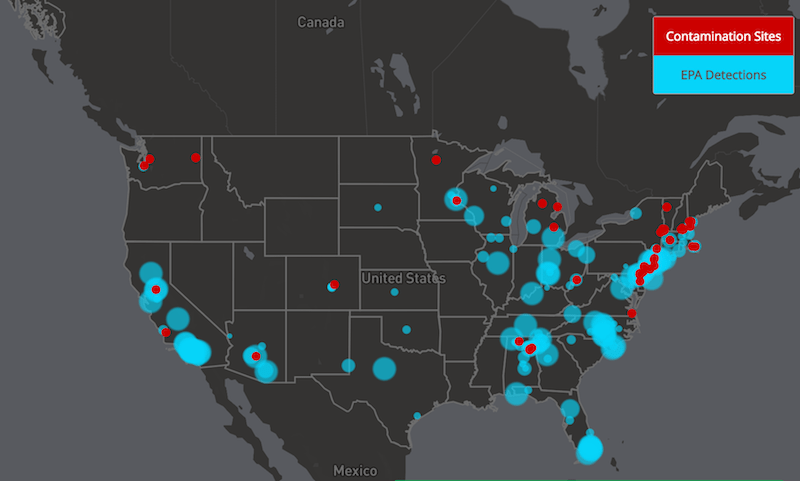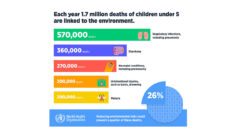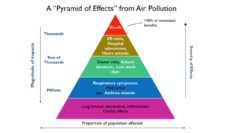Each Wednesday, the Clean Cape Fear Alliance in Wilmington, North Carolina hosts a meeting, usually drawing more than 100 people, to discuss concerns about GenX contamination of the Cape Fear River. GenX is a perfluoroalkyl chemical compound, one of many contaminating waters across the U.S.

The PFAS Family
Per-and polyfluoroalkyl substances (PFASs) are a family of manmade chemical compounds. Perfluorooctanoic acid (PFOA) and perfluoroooctane sulfonate (PFOS) fall within the PFAS family and were the most commonly manufactured PFASs in the U.S. The waterproof and nonstick qualities of the PFASs lend themselves well for use in consumer products such as nonstick pans, outdoor clothing, and firefighting foam.
But research has linked PFASs to cancer, thyroid disease, and immune suppression. A study in JAMA found that exposure to PFASs led to a lower immune response to routine immunizations in children ages 5 to 7. PFASs can also be passed from mother to fetus.
Many chemicals that fall within the PFAS family are therefore no longer produced in the U.S., including PFOA and PFOS. In large part, the voluntary discontinuation of certain PFASs was the consequences of lawsuits against Dupont and 3M.
PFOA and PFOS, despite the discontinuation of production in the U.S., are still widespread. China continues to use both of these substances in their consumer products, which can still be imported into the U.S. The National Health and Nutrition Examination Survey found PFASs in over 98% of the thousands of blood samples collected in their 2003-2004 survey. PFASs do not easily break down, persisting in the environment and human body for many years.
Contaminated Water
The Environmental Working Group and the Social Science Environmental Health Research Institute of Northeastern University have created an interactive map of each PFOA and PFOS contamination site (red) and contaminated public drinking water system (blue).

PFASs contamination was found in water supplies that affects 15 million Americans in 27 states. The contamination comes from more than 48 industrial or military sources. It is important to note that the data used to determine PFOA and PFOS contamination of the public drinking water was taken from data gathered under testing requirements from EPA’s Unmonitored Contaminant Rule (UMCR). The EPA tests all U.S. public drinking water systems for PFOA, PFOS, and few other PFASs, but misses private wells, through which a third of Americans get their water.
GenX: The Supposed Safer Alternative
In the case of Wilmington, GenX has been floating through Cape Fear River for at least a few years now. A company called Chemours, a subsidiary of DuPont, is responsible for the pollution. The portion of the river downstream from Chemours serves as the source of drinking water for about 250,000 people. One study places the GenX concentration in the drinking water of Cape Fear Public Utility Authority at 631 parts per trillion (ppt).
Ironically, GenX was introduced as a safer alternative to replace C8, another PFAS, over which Dupont was sued.
Ironically, GenX was introduced as a safer alternative to replace C8, another PFAS, over which Dupont was sued. There is not a lot of literature on GenX and the potential health implications due to the novel nature of this particular PFAS. The National Institute for Public Health and the Environment in the Netherlands rates GenX as a Category 2 carcinogen or suspected human carcinogen.
Chemours did agree to stop contaminating Cape Fear with GenX starting June 21st, although it had no legal obligation. There are not any enforceable EPA regulations on the appropriate concentration for GenX or any other PFASs – just health advisories or suggestions. The clean-up, however, may not be easy. Flushing the river and pipes of GenX could take several weeks, but, more alarmingly, the chemical could remain in groundwater for many years.
The Unregulated Contaminants
Surprisingly, there are no federal regulations concerning PFOA and PFOS in drinking water despite the health implications. The Environmental Protection Agency (EPA) has a nonbinding health advisory for PFOA and PFOS set at 70 ppt, but even this level may be too high for safety. One study calculated 1 part per trillion of PFOA and PFOS as safe in drinking water. Another study found that any level of PFOA or PFAS adversely affected mouse fetuses during development.
Currently, there are new bills in Congress that would begin to regulate PFASs in the environment. One bill introduced by Senator Kirsten Gillibrand and Charles Schumer would have the EPA create drinking water standards for PFOA and PFOS. Another would have the EPA set enforceable standards for PFASs in drinking water. Certainly, the proposed large cuts to the EPA funding in Trump’s budget do not bode well for future enforcement of expanded contaminant monitoring, especially when enforcement of regulations can involve expensive legal battles.
Feature image: Jimmy Emerson, DVM, The Cape Fear River Taken from the Elwell Ferry landing in Bladen County, North Carolina, used under CC BY-NC-ND 2.0
Screenshot of Interactive U.S. Map: Toxic Fluorinated Chemicals in Tap Water and at Industrial or Military Sites.













